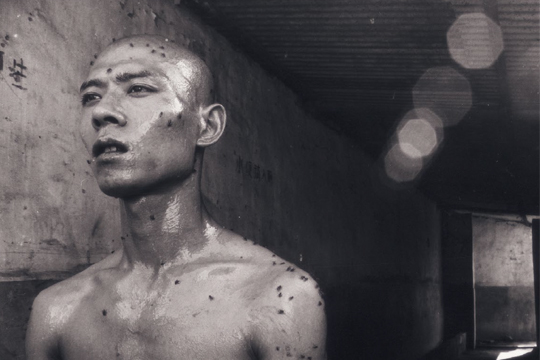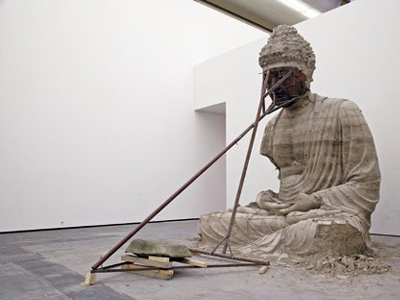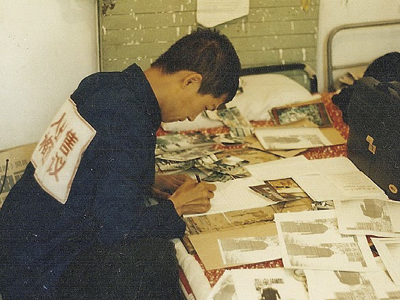REVISITING PERFORMANCE ART OF THE 1990s AND THE POLITICS OF MEDITATION
| August 8, 2013 | Post In LEAP 21

Photos from Zhang Huan’s 1994 piece 12 Square Meters have become emblematic of contemporary Chinese performance art. The artist rests in a moment of stasis, existing within different pulls and sensations. He sits naked on top of a public toilet in the outskirts of Beijing. With his head seemingly finding balance on top of his slightly curved spine, the weight of his torso gravitates downwards on top of his crossed legs. The counterbalance of his upward-sensing spine against the weightedness of his sitting provides the sense of stasis, while his closed eyes furthers this in-between state. This sense of reflection and being in the moment is augmented by Zhang’s lack of reaction to the swarm of flies stuck onto and around his honey-smeared body. The horde of flies makes the viewer aware of the intense stench of the public restroom that permeates the seemingly serene moment that Zhang inhabits.One sees used bits of toilet paper left along the floor, providing a deeper sense of the tactile sensation of flies on the skin, along with the summer heat, and of the smell of urine and feces.
12 Square Meters is an iconic work that scholars have often commented on in terms of its political critique on the rural and urban divides amidst the rapid shifts in China’s economy. Noted historian Wu Hung has described 12 Square Meters as “combin[ing] personal experience with a social critique.” (1) The relationship between aesthetics and politics here is often seen as a one-to-one correspondence, where the artist draws upon personal life to critique the world that surrounds him. Aesthetics is situated as reactionary to politics.
This relationship between aesthetics and politics has been long disputed within critical theory in and outside of China. This article is not meant to give an overview of these debates; rather, it is to focus on how performance art as a bodily practice opens up some new ways of engaging this historically rich relationship between art and the political. Performance art is a site that involves locating the body at a particular historical moment, physical space, and aesthetic experience. As such, this art form provides the opportunity to not simply reflect on politics, but also to shape its contours. By reexamining primarily Zhang Huan’s iconic work from the 1990s and a few other artists from this period, this brief essay explores how aesthetics shapes the terms and conditions of politics, shifting the dominant one-to-one correlation that structures discourse around art emerging out of China. In other words, it is an exploration of a different relationship between aesthetics and politics—not to dismiss the work that has already been done, but to supplement and expand how we think about this dynamic.

In particular, the aesthetics of 12 Square Meters create a unique sense of relationality and consciousness. Theorist Lydia Liu describes how “the irony that, in the very act of criticizing Western domination, one often ends up reifying the power of the dominator to a degree that the agency of non-Western cultures is reduced to a single possibility: resistance.” (2) It is within the notion of resistance that we often imagine artists as gaining consciousness of politics and then creating art that reacts against identifiable problems.
We can see the development of this logic from Mao’s 1942 Yan’an talks on art and politics to Marxist and Frankfurt School theories on the role of art in society. Marx famously correlates consciousness to one’s social situation: “It is not the consciousness of men that determines their being, but, on the contrary, their social being that determines their consciousness.” (3) Marx relates this conscious mind to one’s being, where one obtains class consciousness through alienation and experience. Furthermore, Frankfurt School scholars similarly follow this logic. Herbert Marcuse situates the possibilities of art not through its aesthetics but rather within art’s ability to shift one’s consciousness towards political problems: “Art cannot change the world, but it can contribute to changing the consciousness and drives of the men and women who could change the world.” (4) Most accounts by Marcuse uphold consciousness, inspired by art, as providing the best means for social and political change. This notion of consciousness is the vehicle that drives the conceptualization of aesthetics as anchored and reactionary to politics.
This problem often frames how we discuss artworks, especially those emerging out of the non-West. Chinese artists are usually understood within the framework of what film scholar Rey Chow describes as the idea of “a unified being” with a rational “mind” or “consciousness,” whereby one gains consciousness of political issues and then creates art to react against such problems. (5) However, by revisiting a few key artworks from the 1990s, we can begin to rethink this idea of a unified being, particularly when one focuses on different forms of consciousness that emerge in these artists’ works. Specifically, meditation can be located as a cognitive mode that offers different ways of thinking and existing in relation to the political. Meditation is not offered here as the only way to understand performance art from the 1990s, since much of the work is quite diverse in form and content. Rather, it is offered as an additional way to think about art emerging from this dynamic moment in time.
Meditation is a mode of analysis/imagination that refrains from rapid judgment. Meditation is not a form of imagination that provides consciousness of power or class alienation; instead, it lingers and expands political possibilities and critiques. Although diverse in form, meditation within the Buddhist tradition involves multiple genealogies, yet most stress how meditation involves “a set of practices or experiments in awareness that are performed with an enormous amount of rigor.” (6) In addition to the notion of practice, meditation provides states of being where one becomes “present, so replete with awareness, that no idea of past or future can enter.” (7) Traditional notions of time are destabilized through repeated practice. Subject-object distinctions are similarly reworked, where the relation between subject and other is blurred through the act of being present. Within Taoist qigong and other traditions, delineations between the self, nature, and others are blurred as one’s body is connected to a larger metaphysical entity or force.
Meditation structures Zhang’s performance in 12 Square Meters. He does not merely endure through discomfort; he allows it to become a form of practice and self-cultivation. Zhang’s sitting, along with his acute sense of focus, is located within his present moment, not within the past or future. In other words, he lingers in discomfort and allows meditation to question endurance’s structures. The category of endurance art as applied to Zhang is incomplete, as endurance perpetuates the notion of resistance and agency. Endurance implies a sense of resistance because one must work against a negative force through such a performance. However, here, Zhang is not merely resisting a situation; he lingers and practices within it. The notion of lingering must be differentiated from endurance. The latter usually implies a fixed sense of time. As utilized here, lingering describes the melancholic feeling and dwelling in space and time. When looking at the English etymologies of both words, one sees a convergence of the meanings of linger and endure to be structured around continuation and existence around the fifteenth century. However, before the fifteenth century, these terms had different meanings, where to endure implies “to undergo or suffer” and “to make hard, harden” while to linger involved “to resolve, dwell, or prolong.” To endure involves a durational period where one either suffers or hardens, while to linger involves dwelling. It is precisely within this etymological difference that the notion of lingering implies a type of melancholic weight that is not fully dependent upon a fixed moment in time.
Zhang not only endures, but also lingers in the pleasures and difficulties of discomfort and the social through practice. He cultivates himself not to simply question and endure through power; instead, he performs a more complicated notion of lingering in power and discomfort. his lingering involves destabilizing the forms of resistance that structure dominant notions of the political. Zhang’s recent artistic practices, such as Dharma Circle (2004) and Berlin Buddha (2007), more explicitly reference Buddhism and meditation, as he has become more involved in his own practice. Although Buddhism is more explicit in his later work, 12 Square Meters offers a space to think about how religious philosophy can provide new ways of engaging the history of performance art.
In addition to Zhang, let us consider Song Dong’s Breathing (1996). In this work Song certainly critiques the State, as he lies on the cold winter concrete of Tiananmen Square to allow his ephemeral breaths to accumulate and condense on the ground, offering a renewed sense of life into the oft-contested space of the square. However, through the analytics of meditation, Breathing can be understood as about not only a critique of power, but also a different sense of the political that is embedded in lingering. Through Song’s repeated breaths, he stays in the space to meditate and be present in the moment. Similar to Zhang, Song not only endures but also lingers in the cold to produce a different relationship to the political, one that is not only about the political as action or endurance.

In this focus on meditation, however, how do aesthetics help us rethink the political? Is it political to meditate? As Michel Foucault described, meditation is a technology of the self that “is much more concerned with thought than with action.” (8) This lack of action may seem like a failed politic, as it does not follow the dominant notion of a unified being that gains consciousness and thus performs resistive action. However, the state of meditation in some of these works from the 1990s involves a sense of failure that redefines the political. Meditation moves away from a logic of resistance towards forms of indeterminacy and open-endedness.
Meditative practices centralize failure, relationality, and a shift in how duration/time is conceptualized. The practice resituates these artists’ works as producing an effect that is “productive” in its ability to provide “an hermeneutic to instruct us how to read after the failure of [dominant] narrative meanings.” (9) Literary theorist Lisa Lowe provides a sense of the political possibilities of failure. For Lowe, its possibilities exist not in creative alternative meanings (alternative, in the sense that they may replace dominant narratives) but in open, failed meanings that are formless and provide space to read anew. Thus, failure here produces ways to “imagine [an] otherwise.” (10)
These artists respond to state action, but the meditative practice of their works brings to light the limits of the categories of resistance, agency, time, and endurance. They may be resisting and critiquing the State, but confining discussion of their works to such a discourse perpetuates an image of the Chinese as only capable of such a political narrative. The meditative political critique is deeply enmeshed in failure, highlighting the limits of the notions of agency and resistance. The works discussed here do not offer a sense of positivistic critique; rather, the melancholic mood inspired by the smell of feces and urine and the tactile sensation of flies produces a lingering political confusion that cannot narrativize success. Rather, it narrates a political ambiguity that critiques normative ideas around politics, time, and resistance. From this space, we can begin to expand the idea of the political.
Thus, when engaging this analytic of meditation to other works from the 1990s, we open up new pathways to understand what the bodily practices of performance art arising primarily during the late 1980s and early 90s offer. For example, the gendered performances of Ma Liuming certainly brought to light the State’s role in censoring the nude body. In relation to this, however, Ma’s use of sitting and resting with strangers, as he embodied Fen-Ma Liuming, offers a renewed sense of failure and melancholy that readjusts the political possibilities of Ma’s performances. The act of sitting naked with strangers produces a vulnerability that cannot be scripted only within notions of censorship. Ma’s vulnerability and the failure to produce a coherent political critique force the critic to imagine the political beyond what has typically been understood as action and change. Similarly, Zhu Fadong’s political critiques of the State’s capitalistic relationship to the individual in This Person is For Sale (1994) are expanded through his act of walking within the city streets. Through walking, Zhu produces a lingering and meandering within public space that offers a sense of existing and being that complicates, rather than solely clarifies, how we relate to others on the streets and in politics. Similar to Zhang Huan and Song Dong, Ma and Zhu inspire direct political critique, while additionally destabilizing traditional understandings of the political by emphasizing the import of the lingering and failures within meditative states.
In researching the genealogy of performance art in China, this question may be engaged to think more deeply about how aesthetics changes the conditions and possibilities of politics itself. In turn, this enables us to create additional narratives of performance art that are not solely about the State. The resultant proposal is not to necessarily rewrite our histories of performance art in China; rather, it offers additional genealogies and ideas that although run concurrent with dominant ways of thinking about history, politics, and art, are often subsumed or ignored.
These types of readings are not simply theoretical. We see such approaches by artists working in China today, as they revisit the history of visual and performance art in order to differently engage with the past and its local context. For example, the collective curatorial practices in “Little Movements” by Liu Ding, Carol Yinghua Lu, and Su Wei direct us towards reimagining the history of contemporary art as located in individualized artistic practices. Additionally, in this issue of LEAP, Su Wei more explicitly provides a sense of this critique by locating the contemporary practices of the younger generation of performance artists. In particular, Su identifies Yan Xing and others as relating their personal relationship to history, which results in different understandings of the past. These artists reflect on the terms of art practice, renegotiating the possibilities for art, politics, and China. Hence, similar to the goals of artists working in China today, the discussion of meditation to reframe earlier works from the 1990s furthers the need to rethink the traditional ways politics and aesthetics have been imagined. Such an approach thus destabilizes our historical narratives out of presumed ways of being and forces us to attend to the minute ways we live, breathe, and exist.
Notes:
1. Wu Hung, Transience: Chinese Experimental Art at the End of the Twentieth
Century, University of Chicago Press, 2005, 107
2. Lydia Liu, Translingual Practice: Literature, National Culture, and Translated Modernity – China, 1900-1937, Stanford University Press, Palo Alto, 1995, xv-xvi
3. Karl Marx, A Contribution to the Critique of Political Economy, Forgotten Books, Lexington, 2010, 11-12
4. Herbert Marcuse, The Aesthetic Dimension, Beacon Press, Boston, 1979, 32-33
5. Rey Chow, “The Elusive Material, What the Dog Doesn’t Understand” in New Materialisms: Ontology, Agency, and Politics, Diana Coole, Samantha Frost ed., Duke University Press, Durham, 2010, 223-224
6. Ken Wilber, “Foreword” in The Experience of Meditation, Jonathan Shear ed., Paragon House, St. Paul, 2006, xi
7. Shodo Harada Roshi, “Zazen Meditation in Japanese Rinzai Zen” in The Experience of Meditation, Jonathan Shear ed., Paragon House, St. Paul, 2006, 12
8. Michel Foucault, Technologies of the Self, University of Massachusetts Press, Boston, 1988, 45
9. Lisa Lowe, “Metaphors of Globalization” in Interdisciplinarity and Social Justice: Revisioning Academic Accountability, Joe Parker et al. ed., State University of New York Press, Albany, 2011, 53
10. Kandace Chuh, Imagine Otherwise: On Asian Americanist Critique, Duke University Press, Durham, 2003

